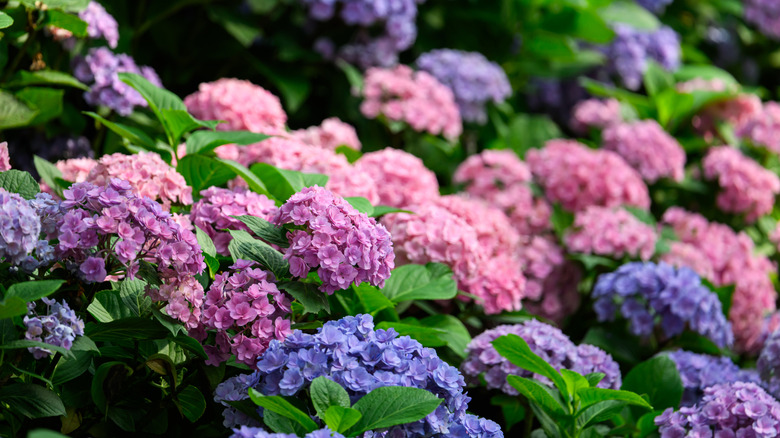The Natural Fix For Powdery Mildew On Hydrangeas
Hydrangeas are a favorite flowering shrub among gardeners. With their dark green leaves and big, showy blossoms in shades ranging from blue to deep pink, they can easily steal the spotlight in any flower garden. But like any plant you grow in your yard, they can come with a list of challenges. One of the most frustrating issues you might face is the fungal disease known as powdery mildew. Luckily, milk has been shown to be a natural and highly effective remedy in preventing this fungal disease. It works because milk contains natural proteins and enzymes that, when exposed to sunlight, produce a free radical which is toxic to fungus. This natural solution can also prevent the powdery mildew from spreading to the rest of your hydrangea.
You've probably encountered powdery mildew if you've ever grown squash or cucumbers. It sets up shop on the leaves of your plant and spreads little threadlike dots that are called mycelium. Although powdery mildew can cause the leaves of hydrangeas to brown and curl, this is more of an aesthetic issue and most likely won't kill the plants outright. Usually, powdery mildew is only a bigger issue for fruiting edible plants, where it can reduce your harvest. However, if left untreated, powdery mildew can cause your hydrangeas to struggle and produce fewer flowers. Therefore, it's a good idea to know how to prevent this common hydrangea issue before planting them in your garden.
Use milk spray and smart planting to stop powdery mildew
To apply milk spray effectively, mix one part milk (whole, skim, or even 2%) with 10 parts of water. Using a clean sprayer or spray bottle, coat the top and underside of the leaves in an even light mist. This should be done twice a week early in the morning, so that the sun's rays can activate the milk's antifungal enzymes. Early morning spraying will help the leaves dry out gradually and prevent further moisture problems that could worsen the powdery mildew issue.
But spray alone isn't enough if you aren't preventing the environmental conditions that promote this fungal disease. You don't want to keep having to spray your hydrangeas every year, do you? Powdery mildew thrives when there is continual moisture and little air flow around plants. That's why where you plant your hydrangea is important. You should avoid planting your hydrangeas in one common area of your yard, and that is under trees. It's also a good idea not to plant them against fences, near walls, or in tight garden beds where humidity can build up and air flow is restricted. Recognizing how your environment can promote diseases like powdery mildew is a huge part of understanding how to grow and take care of hydrangeas successfully.

